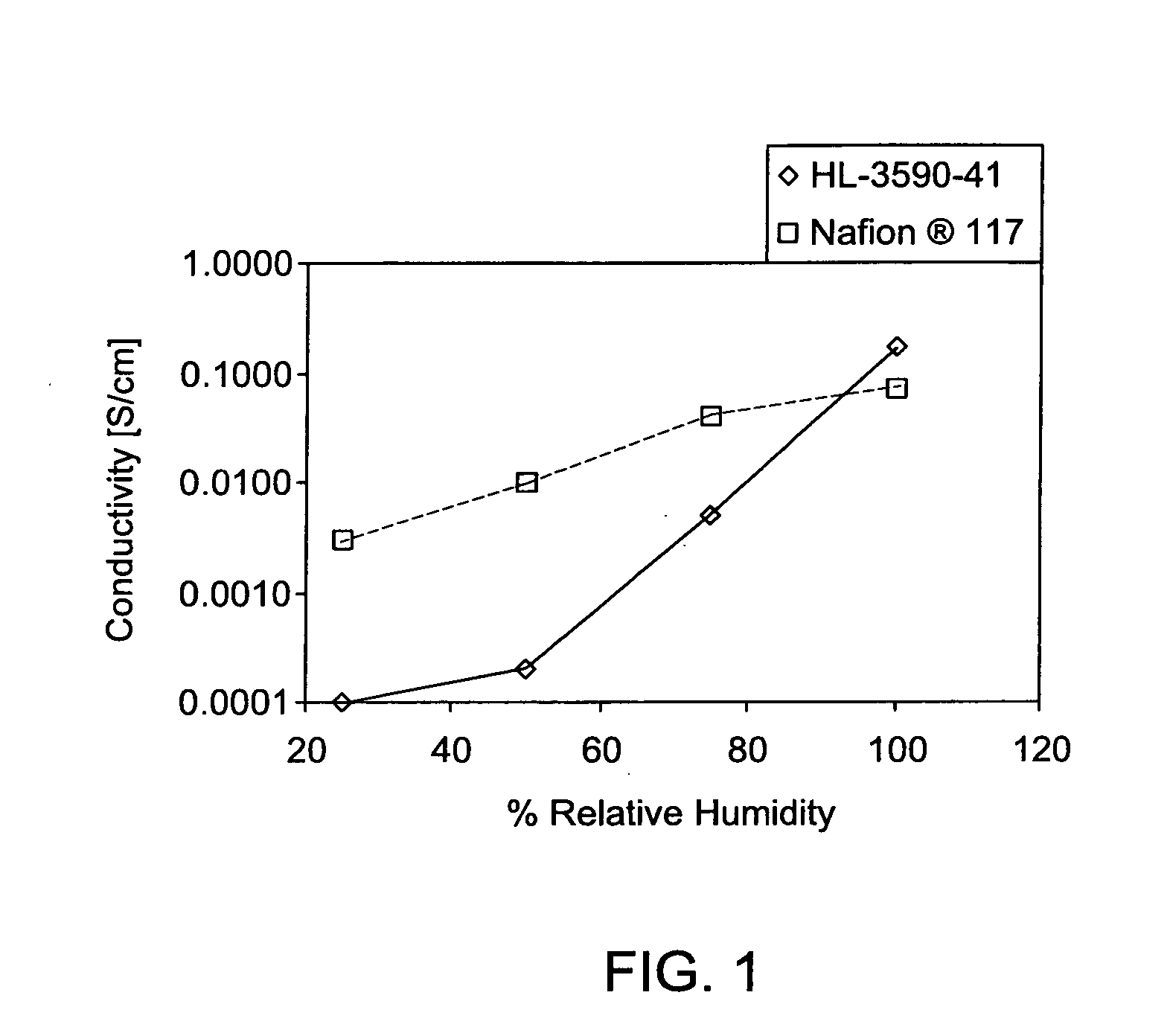Sulfonated polyaryletherketone-block-polyethersulfone copolymers
a polyetherketone and polymer technology, applied in the field of sulfonated polyaryletherketoneblockpolyethersulfone copolymers, can solve the problems of poor performance at low relative humidities, limited widespread use of these membranes, and high cos
- Summary
- Abstract
- Description
- Claims
- Application Information
AI Technical Summary
Benefits of technology
Problems solved by technology
Method used
Image
Examples
example 1
Synthesis of Polyetherketone (PEK)
[0047]4,4′-fluorobenzophenone (2.6184 grams (g), 12 millimole (mmol)), 4,4′-dihydroxytetraphenylmethane (3.5243 g, 10 mmol), dry DMAc (30 mL) and potassium carbonate (1.94 g, 14 mmol) are added into a three neck round bottom flask equipped with a mechanical stirrer and a nitrogen inlet. Toluene (15 mL) is used as an azeotropic agent. The reaction mixture is heated at 155° C. for 4 hours (h), and then at 165° C. for 18 h. The polymer solution becomes viscous and is then cooled to room temperature under nitrogen for the next step reaction.
example 2
Synthesis of Polyethersulfone (PES)
[0048]4,4′-difluorodiphenyl sulfone (4.068 g, 16 mmol), 4,4′-(hexafluoroisopropylidene) diphenol (6.0521 g, 18 mmol) (to give a mole ratio between the monomers 4,4′-dihydroxytetraphenylmethane / 4,4′-(hexafluoroisopropylidene) diphenol of 10:12), dry DMAc (40 mL) and potassium carbonate (3.72 g, 26.7 mmol) are added into a three neck round bottom flask that is equipped with a mechanical stirrer and a nitrogen inlet. Toluene (20 mL) is used as an azeotropic agent. The reaction mixture is heated at 155° C. for 4 h, and then at 165° C. for 18 h. The polymer solution becomes viscous and is then cooled to room temperature under nitrogen for the next step reaction.
example 3
Synthesis of PEK-Block-PES
[0049]Polymer solution of PEK prepared above is transferred to a three neck round bottom flask containing polymer solution of PES at room temperature under nitrogen. The mixture of two polymers is heated to 165° C. for 20 h under nitrogen. The polymer was precipitated into a 1:1 v / v mixture of water and methanol while blending. The precipitated polymer is collected by filtration, and is washed extensively with de-ionized water and ethanol to remove salt, and is finally dried in a vacuum oven overnight.
PUM
| Property | Measurement | Unit |
|---|---|---|
| mol % | aaaaa | aaaaa |
| mol % | aaaaa | aaaaa |
| molecular weight | aaaaa | aaaaa |
Abstract
Description
Claims
Application Information
 Login to View More
Login to View More - R&D
- Intellectual Property
- Life Sciences
- Materials
- Tech Scout
- Unparalleled Data Quality
- Higher Quality Content
- 60% Fewer Hallucinations
Browse by: Latest US Patents, China's latest patents, Technical Efficacy Thesaurus, Application Domain, Technology Topic, Popular Technical Reports.
© 2025 PatSnap. All rights reserved.Legal|Privacy policy|Modern Slavery Act Transparency Statement|Sitemap|About US| Contact US: help@patsnap.com



